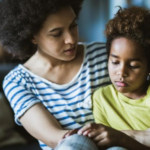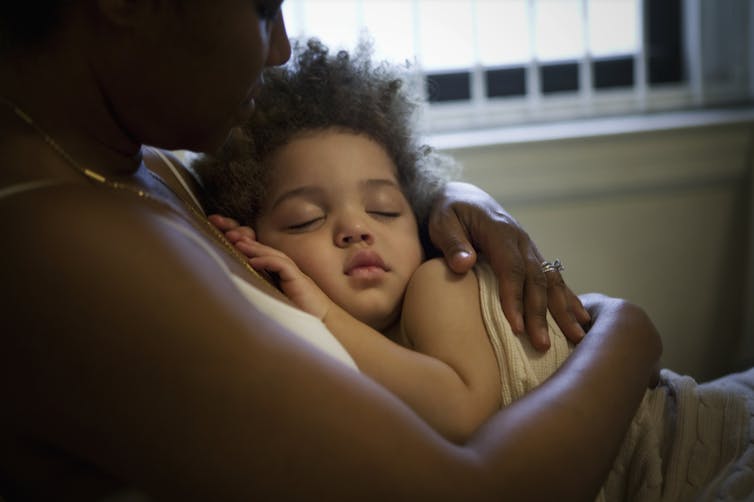
Written by Loren Henderson, associate professor of public policy, UMBC and Ruby Mendenhall, associate professor in sociology, African American studies, urban and regional planning, and social work, University of Illinois at Urbana-Champaign.
Black mothers are the canaries in the coal mine when it comes to the mental and physical harms of stress from living with gun violence in America.
In the U.S., Black people are likelier than white people to reside in impoverished, racially segregated communities with high levels of gun violence. Research has suggested that living in violent and unsafe environments can result in continuous traumatic stress, a constant form of PTSD. Researchers have also linked experiences of violence and poverty to an increased risk of chronic disease such as cancer and cardiovascular, respiratory and neurodegenerative diseases.
We are Black women and public policy and sociology professors who study health inequities and sustainable policy solutions. Our research has found that Black mothers who feel trapped in neighborhoods they perceived as unsafe because of high levels of community violence are more likely to report elevated PTSD and depression symptoms, as well as elevated stress hormone levels.
The trauma of gun violence and systemic racism isn’t simply a Black mother’s story – it’s an American story.
Health effects of feeling trapped
Our research team sought to understand how stress from structural violence affects the body, specifically the immune system. We talked to 68 low-income single Black mothers living on the South Side of Chicago about how they deal with gun violence in their communities and how it affects their health.
We asked these Black mothers to complete surveys that measured depression and PTSD symptoms. We also asked them to provide blood samples to examine the effects of stress at the cellular level, measuring the activity of genes that code for the receptors for the stress hormone cortisol. Looking at cortisol receptors offers a more cumulative measure of cortisol levels over time.
We found that about 65% of the mothers wanted to move out of their neighborhoods but could not afford to do so. These mothers felt trapped in areas with high levels of gun violence that fostered a sense of not feeling safe for adults and children. One mother in our study, whom we will call Ellan, described her neighborhood as dangerous and wanted to leave as soon as she could. “I’m very terrified of my kids going out to the park, playing in front of the house,” she said. “And I’m afraid that a car might come past shootin’ and one of my kids get hurt.”
 Jose Luis Pelaez/The Image Bank via Getty Images
Jose Luis Pelaez/The Image Bank via Getty Images
Another mother in our study, whom we will call Skylar, felt she couldn’t escape to a safer community. “I don’t really want to raise my kids there, but I don’t have a choice. You know, cause it’s what I can afford. But it’s real violent.”
Mothers who felt trapped reported more symptoms of PTSD, like disturbing memories and dreams and reliving stressful experiences, than mothers who did not feel trapped. They also reported more depressive symptoms, such as feeling down and hopeless, taking little pleasure in doing things and having trouble sleeping.
Mothers unable to afford the move to safer neighborhoods had lower levels of glucocorticoid receptors. Having fewer glucocorticoid receptors helped protect their bodies from being overwhelmed by high cortisol levels caused by stress. Nevertheless, high cortisol levels from chronic stress are linked to a number of negative mental and physical health outcomes.
Environment determines health
Where someone lives, learns, works, plays and worships can determine their health and has the power to make them sick and cause premature death.
Researchers have estimated that around 83,570 Black people die prematurely each year in the U.S. because of health disparities, using 2002 data. Some scholars have previously described this as equivalent to a plane full of Black passengers falling out the sky every day every year.
It is important to note that it is not the racial makeup of where a person lives that shapes the significant disparities they face, but exposure to violence, poverty and lack of resources as a result of structural racism. Redlining, environmental contamination, food deserts and gun violence are a part of the racial capitalism, or exploitation of marginalized communities, that affect the health of Black women. https://www.youtube.com/embed/9WIv2oO2Vxs?wmode=transparent&start=0 Black people face systemic economic and health disparities in the U.S.
What we are learning about the constant threats to the safety of Black mothers and their families also applies to the general American public.
The rate of mass shootings is increasing. Firearm fatalities are a leading cause of death among children ages 1 to 19 in the U.S. Gun violence has harmed people while they are watching a parade, shopping at a store, worshipping, attending school and other ordinary events.
Increasing access to wellness
Understanding the complexity of the exposome – the word researchers use for environmental factors like gun violence that affect an individual’s health and well-being – can help extend the years of healthy life of groups who typically experience premature death. Building this knowledge requires input from people of color and others who have traditionally been pushed to the margins of society.
We are currently creating a “wellness store” that places wellness tools and health knowledge at the fingertips of individuals, especially for those experiencing interlocking traumas such as racism, sexism, classism, incarceration, racial segregation and rural geographic isolation. These tools, co-created with community health workers and citizen scientists, range from phone apps to public policy designed to get stress “out from under the skin.” Our goal is to work with clinics, hospitals and community organizations to provide accessible tools to prevent illness.
Black communities are filled with resilient and vulnerable individuals who deserve urgent policy solutions that lead to societal change. We believe that more investment in disease prevention and health equity can help the U.S. use the knowledge, technology and finances that it already has to help people access its most precious resource: a healthy life and the ability to pursue wellness.
This article is republished from The Conversation under a Creative Commons license. Read the original article and see more than 250 UMBC articles available in The Conversation.





